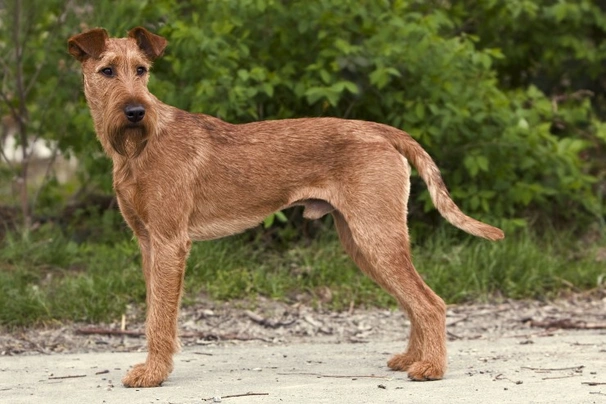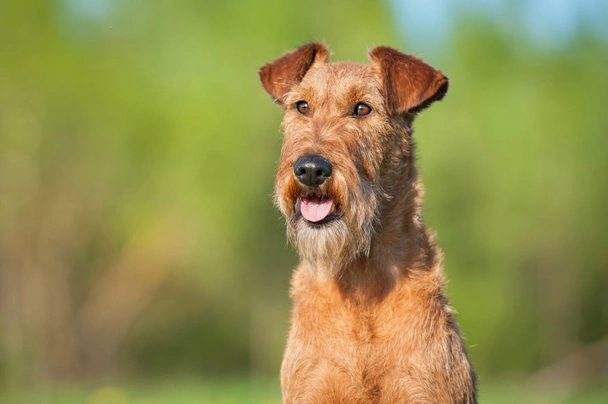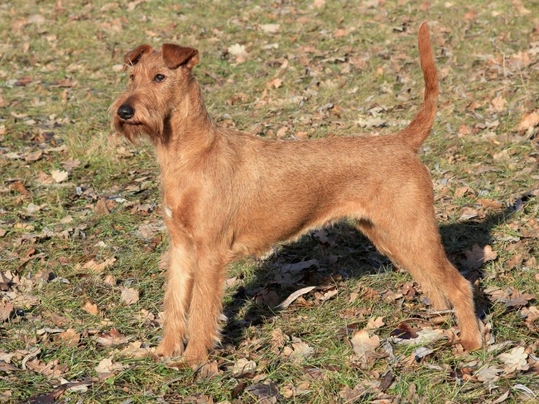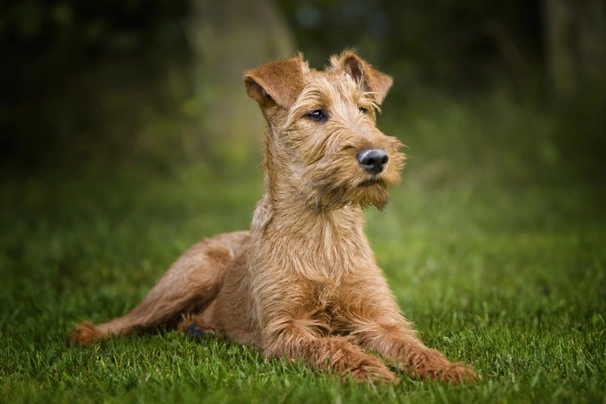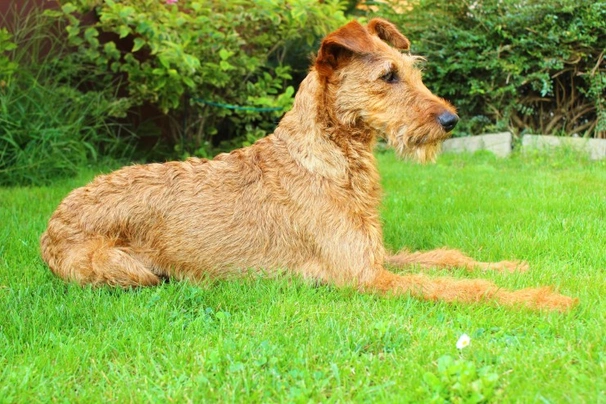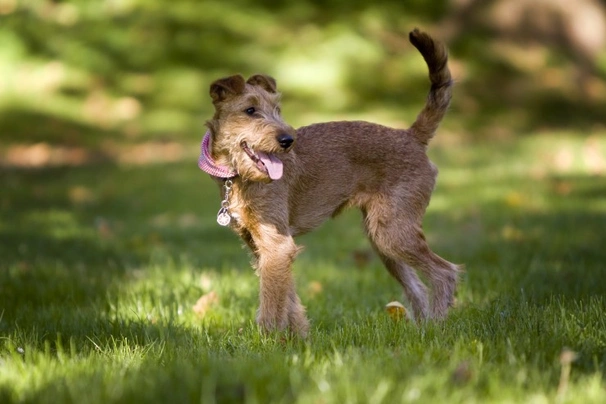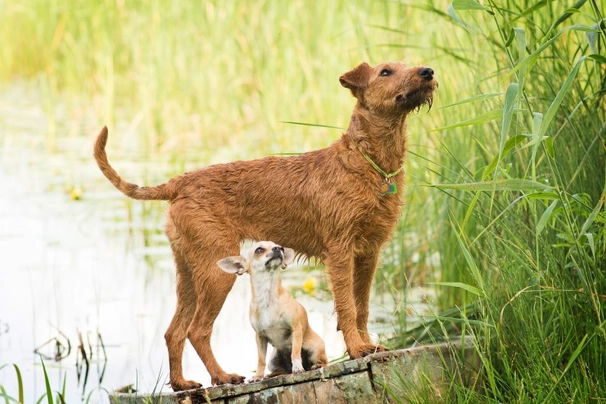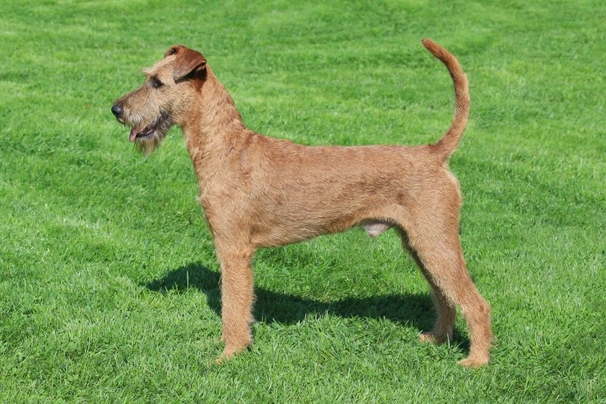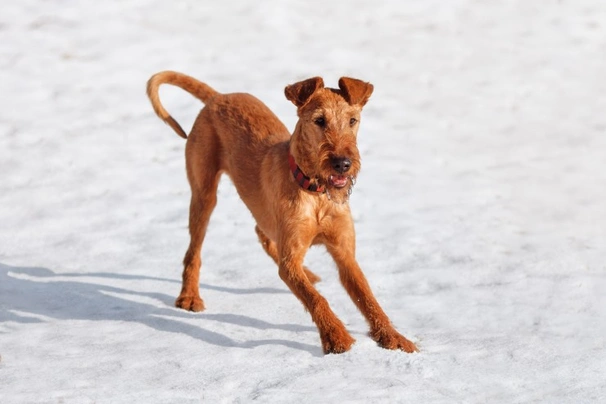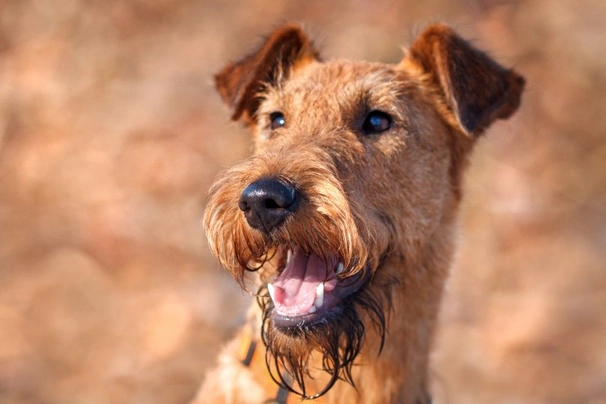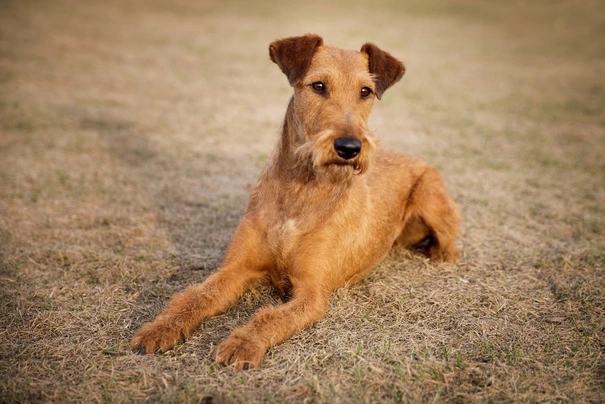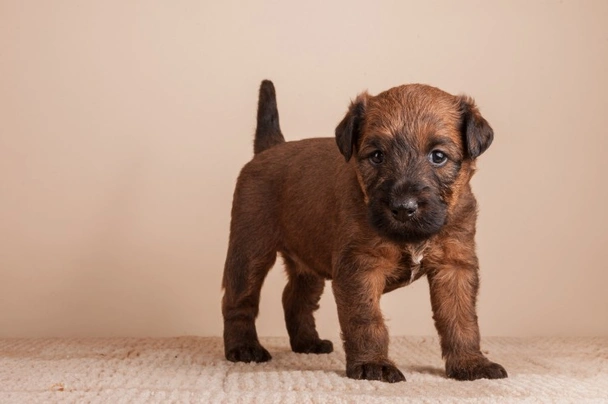Irish Terrier
Pros
Cons
Introduction of the Irish Terrier
The Irish Terrier is a lively alert yet gentle character and one that boasts a fun-loving side to their nature. These charming long-legged terriers seem to have an affinity with children which makes them the perfect family pet. They also seem to be able to read a person's mood which is another of their many endearing traits. However Irish Terriers are classed as being a vulnerable native breed with very few puppies being bred and registered with The Kennel Club every year even though they make such wonderful companions and family pets.
As such anyone wanting to share a home with an Irish Terrier would need to register their interest with breeders and agree to go on a waiting list for the pleasure of doing so. The good news is that the wait would be well worth it because having a canine companion like an Irish Terrier in the home would always mean being wonderfully entertained.
History of the Irish Terrier
The Irish Terrier is thought to be the oldest of all Irish terrier breeds. They are native to Ireland although there are not many records of the breed that date back to ancient times. With this said small terrier-type dogs were always seen around Irish farms throughout time because they were invaluable at keeping vermin under control. These little terriers were also used to guard and protect livestock and terrier-types were written about in the Brehon Laws which date back to the Middle Ages.
Although the actual origins of the breed remain a bit of a mystery there are some people who believe they were created by crossing Irish Wolfhounds with black and tan terrier-type dogs that were around at the time. This theory is supported by the fact that Irish Terriers do resemble a smaller version of the Irish Wolfhound. Other people think the breed was originally created in Cork Southern Ireland although another theory is that these charming long-legged terriers were created by crossing Black and Tans with Wheaten Terriers.
They were once referred to as Irish Red Terriers which was to set them apart from other breeds. In 1875 the first dog was exhibited at a dog show held in Ireland after which time the breed was the first of the Irish Terriers to be officially recognised by The Kennel Club.
By the end of the 19th Century breeders were trying to breed out several colours which included brindle and black & tan. The end goal being to only have "red coated" Irish Terriers by the 20th Century. At the same time a movement that was established to prevent terriers from having their ears "cropped" was recognised by the Kennel Club and a ban was set in place. As such no Irish Terrier puppies born after the end of December 1889 could have their ears cropped.
The Irish Terrier Club which was founded in 1879 and went on to successfully promote the breed right up to the First World War with dogs commanding a high price at the time. The breed’s popularity spread not only across England but to the United States too. Thanks to their courage and determination Irish Terriers were used as messengers during World War I when they were used to take vital messages to troops on the front proving they were extremely courageous and loyal.
After the First and Second World Wars breed numbers fell dangerously low but thanks to the efforts of several breed enthusiasts Irish Terriers did not vanish altogether and most dogs today can trace their ancestry to the terriers that these breeders saved from extinction. Breed numbers however remain low with few well-bred Irish Terrier puppies being bred and registered with The Kennel Club every year even though they are charming dogs that get on with everyone and are super well behaved around children. As such anyone wishing to share a home with an Irish Terrier would need to find a breeder and agree to be put on a waiting list because puppies are so rare.
Interesting facts about the breed
- Is the Irish Terrier a vulnerable breed? Yes the breed is on the Kennel Club's native vulnerable breed list although their numbers are slowly rising every year
- Irish Terriers were used as messengers during World War I
- Well-bred Irish Terriers can command a lot of money because breed numbers are low
- Traditionally an Irish Terrier's tail was always docked but since the law banning the procedure came into effect in 2007 tail docking is now illegal with the exception being for some working breeds and if a dog suffers from some sort of health issue that requires their tails to be docked. The procedure must be agreed and authorised before being performed by a qualified vet and anyone who carries out the procedure or who owns a dog with an illegally docked tail would be liable for a hefty fine
Appearance of the Irish Terrier
Height at the withers: Males 46 - 48 cm Females 46 - 46 cm
Average weight: Males 11 - 15 kg Females 11 - 12 kg
Irish Terriers are longer in the leg than most terriers which gives them a very elegant appearance. They boast having a wiry coat and charmingly alert expression. Their heads are long being flat and rather narrow between the ears although narrower still towards a dog's eyes. Their stop can only be seen when looking at their profile. Their jaws are strong with their forefaces being nicely chiseled. Lips are tight and black in colour and their noses are black too**.**
They have quite small eyes and their ears are V-shaped being small in size and set well on a dog's head. They are quite thick to the touch and drop forwards lying close to a dog’s cheeks with the very top of the ear folded neatly forward. The hair on an Irish Terrier's ears is darker and shorter than on the rest of their body. They have a strong jaw with a perfect scissor bite where their upper teeth neatly overlap their lower ones.
Their necks are quite long and widen at a dog's shoulders which allows them to hold their heads high. Dogs have a fringe on each side of their necks which almost reaches the corner of their ears. Their shoulders are long well laid back and fine with dogs having longer legs than a lot of other terrier breeds. Their legs are straight well-muscled showing a good amount of bone.
They have muscular deep chests and nice strong long and straight backs. Loins are slightly arched and well-muscled with dogs having nicely laid back well sprung ribs which are deep rather than round. Back legs are strong with powerful thighs with the hair being thick and crisp to the touch. Their feet are strong and quite round shaped being on the smallish side with nicely arched toes and strong black toe nails. Tails are set quite high which dogs carry gaily. They are well covered with hair but no fringe or feathering.
When it comes to their coat the Irish Terrier boasts having a wiry harsh flat and straight top coat and a much softer finer undercoat. The hair on their forefaces is crisp being slightly longer than it is on the rest of the body. The hair on a dog's legs is thick and much crisper to the touch. The accepted breed colours are as follows:
- Red
- Red Wheaten
- Rust
- Wheaten
- Wheaten Red
Gait/movement
When an Irish Terrier moves they do so with great purpose with their front and back legs being carried nicely straight and forward in a parallel action. They keep their elbows perpendicular to their bodies with their stifles not turning in or out.
Faults
The Kennel Club frowns on any exaggerations or departures from the breed standard and would judge the faults on how much they affect a dog's overall health and wellbeing as well as their ability to perform.
Males should have both testicles fully descended into their scrotums and it is worth noting that a dog can be a little lighter or heavier as well as slightly taller or shorter than set out in the Kennel Club breed standard which is only given as a guideline.
Temperament of the Irish Terrier
The Irish Terrier is a bold little dog and one that is often referred to as being a little "foolhardy and reckless". However with this they are known to be one of the gentlest of all terriers around. They are renowned for being exceptionally good with children and seem to have a real affinity with them. They are also known to be able to "read" an owner's mood which is another of their endearing traits and why they make such wonderful family pets and companion dogs. They form extremely strong bonds with their owners and their families which can be a bit of a problem when an Irish Terrier is left on their own for any length of time. As such they are best suited to families where one person usually stays at home when everyone else is out of the house.
They are intelligent and as such need to be given a heap of mental stimulation every day for them to be truly happy well-rounded characters. If they are left to their own devices for longer periods of time they can become hyperactive and quite destructive around the house thanks to the fact an Irish Terrier will quickly find new ways to amuse themselves. They are quick witted and exceptionally good at "problem solving" which means they can get up to a bit of mischief when the mood takes them especially if they are not given enough exercise and boredom sets in.
They are naturally very protective of their families and property which means they are excellent watch dogs and will quickly let an owner know when there any strangers are about or when there is something happening that makes these little terriers nervous. Because they are so protective puppies must be well socialised from a young enough age so that this particular trait can be gently curbed otherwise it could turn into a real problem later in a dog's life. Early socialisation also helps these terriers accept being around other dogs they meet. When they are not properly socialised Irish Terriers can be a little on the aggressive side when they are around other dogs.
Are they a good choice for first time owners?
Irish Terriers are a good choice for first time dog owners providing they have the time to dedicate to an energetic canine companion that has a low boredom threshold. They are particularly good with young children and older people too although playtime can get a bit boisterous at times.
What about prey drive?
Although Irish Terriers are very social by nature they have a high prey drive and would happily give chase to any animal or pet that tries to run away from them. As such care should always be taken as to where and when an Irish Terrier can run off the lead more especially when they are anywhere near wildlife or livestock.
What about playfulness?
Irish Terriers have a very playful side to their natures and love to entertain and be entertained. They are known to be a little mischievous when the mood takes them and being so clever they quickly learn what pleases an owner and how to get their way when the mood takes them. One of their greatest joys is to dig and this can be furniture carpets or outside in a garden an Irish Terrier takes great delight in digging up flowerbeds and lawns.
What about adaptability?
Irish Terriers are highly adaptable dogs and providing they are given enough daily physical exercise combined with as much mental stimulation to prevent boredom from setting in they are just as happy living in an apartment in town as they would be living in a house in the country bearing in mind that garden fencing must be extremely secure to keep an Irish Terrier safely in.
What about separation anxiety?
Although Irish Terriers form strong ties with their families they are quite independent characters by nature and as such they are not known to suffer from anxiety. With this said they have a very low boredom threshold which means that if left to their own devices for too long an Irish Terrier would quickly find novel ways of amusing themselves which could include being destructive around the home and barking incessantly to get some attention.
What about excessive barking?
Some Irish Terriers like the sound of their own voices a little too much which is something that needs to be gently nipped in the bud when a dog is still young being careful not to frighten them which could end up making them timid and shy. Others will only bark when there are strangers about or when something they don't like is going on in their surroundings.
Do Irish Terriers like water?
Most Irish Terriers love swimming and will take to the water whenever they can more especially when the weather is hot. However if anyone who owns a dog that does not like water should never force them to go in because it would just end up scaring them. With this said care should always be taken when walking an Irish Terrier off the lead anywhere near more dangerous watercourses just in case a dog decides to leap in and then needs rescuing because they cannot get out of the water on their own.
Are Irish Watchdogs good watchdogs?
Irish Watchdogs are natural watchdogs which is a trait that is deeply embedded in their psyche. As such they do not need to be "taught" to guard and protect which could end up making an Irish Terrier more dominant and aggressive which is something to be avoided at all costs. With this said an Irish Setter would be quick off the mark to let an owner know when strangers are about but rarely would a dog go about this aggressively.
Intelligence / Trainability of the Irish Terrier
Irish Terriers are very intelligent little dogs and they have a real desire to please which in short means in the right hands and environment they are easy to train. The bonus being they thoroughly enjoy the one-to-one attention they are given during a training session. They excel at all sorts of canine sports which includes activities like flyball agility and obedience.
The key to successfully training an Irish Terrier is to keep each session as interesting as possible and to avoid too much repetition. Lots of shorter training sessions are better than a few long ones because it keeps these smart little terriers more focused on what they are being asked to do. Having a dog’s full attention is half the battle when training them.
Their training must start early and it must be consistent throughout a dog’s life. It also should fair to bring the best out of these little terriers. They respond extremely well to positive reinforcement but being sensitive by nature they do not answer well to any short of harsh correction or heavier handed training methods which could result in dogs becoming shy withdrawn and timid.
Irish Terrier puppies are incredibly cute and it is all too easy to spoil them when they first arrive in their new homes. However owners need to start out as they mean to go on bearing in mind that Irish Terriers are not the most obedient dogs by nature. As such rules and boundaries must be set out right from the word go so that a puppy understands what is acceptable behaviour and what is not. All puppies will test the rules from time to time so it is important to remain consistent. The first commands a puppy should be taught are as follows paying special attention to the "recall" command:
- Come
- Sit
- Stay
- Heel
- Quiet
- Leave it
- Down
- Bed
Children and other
Irish Terriers are always on their best behaviour when they are around children and seem to have a real affinity with them. However they can be a little feisty and boisterous at times which means they might accidentally knock a toddler over. As such any interaction between younger children and a dog should always be supervised by an adult to make sure playtime does not get too rough which could end up frightening or injuring a child.
Even when an Irish Terrier has been well socialised from a young age they can be a little aggressive around other dogs which is especially true of male dogs. If they feel threatened in any way an Irish Terrier will take on another dog and rarely would they back down from a fight no matter how big or small the other dog happens to be. As such care must be taken when out on a walk where other dogs are usually being exercised.
If they have grown up with a family cat in the home they generally get on well together however an Irish Terrier would soon see off any other cat they come across. Because of their high prey drive care should be taken when they are around any smaller animals and pets just in case. In short any contact is best avoided.
Health of the Irish Terrier
The average life expectancy of an Irish Terrier is between 13 and 15 years when properly cared for and fed an appropriate good quality diet to suit their ages.
The Irish Terrier is known to be a robust dog and one that does not seem to suffer from many hereditary health issues that so often plague other breeds. With this said the one condition that seems to affect them although it is quite rare is as follows:
- Cystinuria Sinuses
- Hyperkeratosis - dogs can be DNA tested
What about vaccinations?
Irish Terrier puppies would have been given their initial vaccinations before being sold but it is up to their new owners to make sure they have their follow-up shots in a timely manner with the vaccination schedule for puppies being as follows:
- 10 -12 weeks old bearing in mind that a puppy would not have full protection straight away but would be fully protected 2 weeks after they have had their second vaccination
There has been a lot of discussion about the need for dogs to have boosters. As such it's best to talk to a vet before making a final decision on whether a dog should continue to have annual vaccinations which are known as boosters.
What about spaying and neutering?
A lot of vets these days recommend waiting until dogs are slightly older before spaying and neutering them which means they are more mature before undergoing the procedures. As such they advise neutering males and spaying females when they are between the ages of 6 to 9 months old and sometimes even when a dog is 12 months old.
Other vets recommend spaying and neutering dogs when they are 6 months old but never any earlier unless for medical reasons. With this said many breeds are different and it is always advisable to discuss things with a vet and then follow their advice on when a dog should be spayed or neutered.
What about obesity problems?
Irish Terriers can gain weight after they have been spayed or neutered and it's important to keep an eye on a dog's waistline just in case they do. If a dog starts to put on weight it's important to adjust their daily calorie intake and to up the amount of exercise they are given. Older dogs too are more prone to gaining weight and again it's essential they be fed and exercised accordingly because obesity can shorten a dog's life by several years. The reason being that it puts a lot of extra strain on a dog's internal organs including the heart which could prove fatal.
What about allergies?
Some Irish Terriers are prone to suffering from allergies and it's important for a dog to see a vet sooner rather than later if one flares up. Allergies can be notoriously hard to clear up and finding the triggers can be challenging. With this said a vet would be able to make a dog with an allergy more comfortable while they try to find out the triggers which could include the following:
- Certain dog foods that contain high levels of grain and other cereal fillers
- Airborne pollens
- Dust mites
- Environment
- Flea and tick bites
- Chemicals found in everyday household cleaning products
Participating in health schemes
All responsible Irish Terrier breeders would ensure that their stud dogs are tested for known hereditary and congenital health issues known to affect the breed by using the following scheme:
What about breed specific breeding restrictions?
Apart from the standard breeding restrictions that apply to all Kennel Club registered breeds there are no other breed specific breeding restrictions in place for the Irish Terrier.
What about Assured Breeder Requirements?
Currently there are no BVA DNA tests or screening schemes available for the Irish Terrier but prospective owners should always discuss health concerns with breeders prior to buying a puppy from them. The one health test available for Irish Terriers is as follows:
- DNA test - HFH
Caring for the Irish Terrier
As with any other breed Irish Terriers need to be groomed on a regular basis to make sure their coats and skin are kept in top condition. They also need to be given regular daily exercise to ensure they remain fit and healthy. On top of this dogs need to be fed good quality food that meets all their nutritional needs throughout their lives.
Caring for an Irish Terrier puppy
Irish Terrier puppies are boisterous and full of life which means it's essential for homes and gardens to be puppy-proofed well in advance of their arrival. A responsible breeder would have well socialised their puppies which always leads to more outgoing confident and friendly dogs right from the word go. With this said any puppy is going to feel vulnerable when they leave their mother and littermates which must be taken into account. The longer a puppy can remain with their mother the better although it should never be for too long either.
It's best to pick a puppy up when people are going to be around for the first week or so which is the time needed for a puppy to settle in. Puppy-proofing the home and garden means putting away any tools and other implements that a boisterous puppy might injure themselves on. Electric wires and cables must be put out of their reach because puppies love chewing on things. Toxic plants should be removed from flowerbeds and the home too.
Puppies need to sleep a lot to grow and develop as they should which means setting up a quiet area that's not too out of the way means they can retreat to it when they want to nap and it's important not to disturb them when they are sleeping. It's also a good idea to keep "playtime" nice and calm inside the house and to have a more active "playtime" outside in the garden which means puppies quickly learn to be less boisterous when they are inside.
The documentation a breeder provides for a puppy must have all the details of their worming date and the product used as well as the information relating to their microchip. It is essential for puppies to be wormed again keeping to a schedule which is as follows:
- Puppies should be wormed at 6 months old
- They need to be wormed again when they are 8 months old
- Puppies should be wormed when they are 10 months old
- They need to be wormed when they are 12 months old
Things you'll need for your puppy
There are certain items that new owners need to already have in the home prior to bringing a new puppy home. It's often a good idea to restrict how much space a puppy plays in more especially when you can't keep an eye on what they get up to bearing in mind that puppies are often quite boisterous which means investing in puppy gates or a large enough playpen that allows a puppy the room to express themselves while keeping them safe too. The items needed are therefore as follows:
- Good quality puppy or baby gates to fit on doors
- A good well-made playpen that's large enough for a puppy to play in so they can really express themselves as puppies like to do
- Lots of well-made toys which must include good quality chews suitable for puppies to gnaw on bearing in mind that a puppy will start teething anything from when they are 3 to 8 months old
- Good quality feed and water bowls which ideally should be ceramic rather than plastic or metal
- A grooming glove
- A slicker brush or soft bristle brush
- Dog specific toothpaste and a toothbrush
- Scissors with rounded ends
- Nail clippers
- Puppy shampoo and conditioner which must be specifically formulated for use on dogs
- A well-made dog collar or harness
- A couple of strong dog leads
- A well-made dog bed that's not too small or too big
- A well-made dog crate for use in the car and in the home that's large enough for a puppy to move around in
- Baby blankets to put in your puppy's crate and in their beds for when they want to nap or go to sleep at night
Keeping the noise down
All puppies are sensitive to noise including Irish Terrier puppies. It's important to keep the noise levels down when a new puppy arrives in the home. TVs and music should not be played too loud which could end up stressing a small puppy out.
Keeping vet appointments
As previously mentioned Irish Terrier puppies would have been given their first vaccinations by the breeders but they must have their follow up shots which is up to their new owners to organise. The vaccination schedule for puppies is as follows:
- 10 -12 weeks old bearing in mind that a puppy would not have full protection straight away but would only be fully protected 2 weeks after they have had their second vaccination
When it comes to boosters it's best to discuss these with a vet because there is a lot of debate about whether a dog really needs them after a certain time. However if a dog ever needed to go into kennels their vaccinations would need to be fully up to date.
What about older Irish Terriers when they reach their senior years?
Older Irish Terriers need lots of special care because as they reach their golden years they are more at risk of developing certain health concerns. Physically a dog's muzzle may start to go grey but there will be other noticeable changes too which includes the following:
- Coats become coarser
- A loss of muscle tone
- Irish Terriers can either become overweight or underweight
- They have reduced strength and stamina
- Older dogs have difficulty regulating their body temperature
- They often develop arthritis
- Immune systems do not work as efficiently as they once did which means dogs are more susceptible to infections
Older dogs change mentally too which means their response time tends to be slower as such they develop the following:
- They respond less to external stimuli due to impaired vision or hearing
- They tend to be a little pickier about their food
- They have a lower pain threshold
- Become intolerant of any change
- Often an older dog can feel disorientated
Living with an Irish Terrier in their golden years means taking on a few more responsibilities but these are easily managed and should include taking a look at their diet the amount of exercise they are given how often their dog beds need changing and keeping an eye on the condition of their teeth.
Older Irish Terriers need to be fed a good quality diet that meets their needs at this stage of their lives all the while keeping a close eye on a dog's weight. A rough feeding guide for older dogs is as follows bearing in mind they should be fed highly digestible food that does not contain any additives:
- Protein content should be anything from 14 – 21%
- Fat content should be less than 10%
- Fibre content should be less than 4%
- Calcium content should be 0.5 – 0.8%
- Phosphorous content should be 0.4 – 0.7%
- Sodium content should be 0.2 – 0.4%
Older Irish Terriers don't need to be given the same amount of daily exercise as a younger dog but they still need the right amount of physical activity to maintain muscle tone and to prevent a dog from putting on too much weight. All dogs need access to fresh clean water and this is especially true of older dogs when they reach their golden years because they are more at risk of developing kidney disorders.
Grooming of the Irish Terrier
Irish Terriers boast have a wiry outer coat and a much softer denser undercoat which is quite easy maintenance. A weekly brush is all it takes to keep their coats tidy and to remove any dead and loose hair. They shed throughout the year although more so during the Spring and then again in the Autumn when more frequent grooming is usually necessary to keep on top of things. Their coats need to be hand stripped several times a year which makes it easier to keep it tidy in between visits to a grooming parlour. The hair between a dog's paw pads also needs to be trimmed when it gets too long to prevent it from balling up which can make walking painful.
It's also important to check a dog's ears on a regular basis and to clean them when necessary. If too much wax builds up in a dog's ears it can lead to a painful infection which can be hard to clear up. In short prevention is often easier than cure when it comes to ear infections.
Exercise of the Irish Terrier
The Irish Terrier is a high energy intelligent dog and as such they need to be given the right amount of daily exercise and mental stimulation for them to be truly happy well-rounded dogs. They need to be given anything from 40 to 60 minutes exercise a day with as much off the lead time as possible. If they are not given the right amount of mental stimulation and exercise every day an Irish Terrier would quickly get bored and could even begin to show some destructive behaviours around the home.
A shorter walk in the morning would be fine but a longer more interesting one in the afternoon is a must. These dogs also like to be able to roam around a back garden as often as possible so they can really let off steam. However the fencing must be extremely secure to keep these high energy dogs in because if they find a weakness in the fence they will soon escape out and get into all sorts of trouble. They are also known to be exceptionally good at digging their way out of gardens which is something owners need to bear in mind.
With this said Irish Terrier puppies should not be over exercised because their joints and bones are still growing. This includes not letting a dog jump up and down from furniture or going up or down the stairs. Too much pressure placed on their joints and spines at an early age could result in a dog developing serious problems later in their lives.
Feeding of the Irish Terrier
If you get an Irish Terrier puppy from a breeder they would give you a feeding schedule and it's important to stick to the same routine feeding the same puppy food to avoid any tummy upsets. You can change a puppy's diet but this needs to be done very gradually always making sure they don't develop any digestive upsets and if they do it's best to put them back on their original diet and to discuss things with the vet before attempting to change it again.
Older dogs are not known to be fussy eaters but this does not mean you can give them a lower quality diet. It's best to feed a mature dog twice a day once in the morning and then again in the evening making sure it's good quality food that meets all their nutritional requirements. It's also important that dogs be given the right amount of exercise so they burn off any excess calories or they might gain too much weight which can lead to all sorts of health issues. Obesity can shorten a dog's life by several years so it's important to keep an eye on their waistline from the word go.
Feeding guide for an Irish Terrier puppy
Puppies need to be fed a highly nutritious good quality diet for them to develop and grow as they should. As a rough guide an Irish Terrier puppy can be fed the following amounts every day making sure their meals are evenly spread out throughout the day and it's best to feed them 3 or 4 times a day:
- 2 months old - 153g to 181g depending on puppy's build
- 3 months old - 179g to 213g depending on puppy's build
- 4 months old - 191g to 229g depending on puppy's build
- 5 months old - 194g to 233g depending on puppy's build
- 6 months old - 194g to 233g depending on puppy's build
- 8 months old - 157g to 201g depending on puppy's build
- 10 months old - 139g to 167g depending on puppy's build
Once a puppy is 12 months old they can be fed adult dog food.
Feeding guide for an adult Irish Terrier
Once fully mature an adult Irish Terrier must be fed a good quality diet to ensure their continued good health. As a rough guide an adult Irish Terrier can be fed the following amounts every day:
- Dogs weighing 11 kg can be fed 149g to 196g depending on activity
- Dogs weighing 12 kg can be fed 159g to 209g depending on activity
- Dogs weighing 14 kg can be fed 178g to 235g depending on activity
- Dogs weighing 15 kg can be fed 187g to 249g depending on activity
Irish Terrier price
If you are looking to buy an Irish Terrier you would need to register your interest with a breeder and agree to being put on a waiting list because very few puppies are bred and registered with The Kennel Club every year. You would need to pay anything upwards of £500 for a well-bred pedigree puppy. The cost of insuring a male 3-year-old Irish Terrier in northern England would be £20.98 a month for basic cover but for a lifetime policy this would set you back £43.21 a month (quote as of February 2018). When insurance companies calculate a pet's premium they factor in several things which includes where you live in the UK a dog's age and whether they have been neutered or spayed among other things.
When it comes to food costs you need to buy the best quality food whether wet or dry making sure it suits the different stages of a dog’s life. This would set you back between £30 - £40 a month. On top of this you need to factor in veterinary costs if you want to share your home with an Irish Terrier and this includes their initial vaccinations their annual boosters the cost of neutering or spaying a dog when the time is right and their yearly health checks all of which quickly adds up to over £900 a year.
As a rough guide the average cost to keep and care for an Irish Terrier would be between £60 to £90 a month depending on the level of insurance cover you opt to buy for your dog but this does not include the initial cost of buying a healthy well-bred Kennel Club registered pedigree Irish Terrier puppy.
Buying advice
When visiting and buying any puppy or dog there are many important things to consider and questions to ask of the breeder/seller. You can read our generic puppy/dog advice here which includes making sure you see the puppy with its mother and to verify that the dog has been wormed and microchipped.
Irish Terriers are a vulnerable native breed but they are gaining in popularity both in the UK and the United States which means that well-bred healthy puppies can often command a lot of money. As such with Irish Terriers there is specific advice questions and protocols to follow when buying a puppy which are as follows:
- Beware of online scams and how to avoid them. You may see online and other adverts by scammers showing images of beautiful Irish Terrierpuppies for sale at very low prices. However the sellers ask buyers for money up front before agreeing to deliver a puppy to a new home. Potential buyers should never buy a puppy unseen and should never pay a deposit or any other money online to a seller. You should always visit the pet at the sellers home to confirm they are genuine and make a note of their address.
- As previously touched upon although Irish Terriers are a vulnerable native breed they are gaining popularity in the UK. As such there are many amateur breeders/people who breed from a dam far too often so they can make a quick profit without caring for the welfare of the puppies their dam or the breed in general. Under Kennel Club rules a dam can only produce 4 litters and she must be between a certain age to do so. Anyone wishing to buy an Irish Terrier puppy should think very carefully about who they purchase their puppy from and should always ask to see the relevant paperwork pertaining to a puppy's lineage their vaccinations and their microchipping.
- Prospective owners should be very careful when considering buying an Irish Terrier puppy with a docked tail and should ask to see the relevant documentation on why a tail has been docked to avoid being liable for a hefty fine.

Beautiful Irish Terrier pups
£2,000
